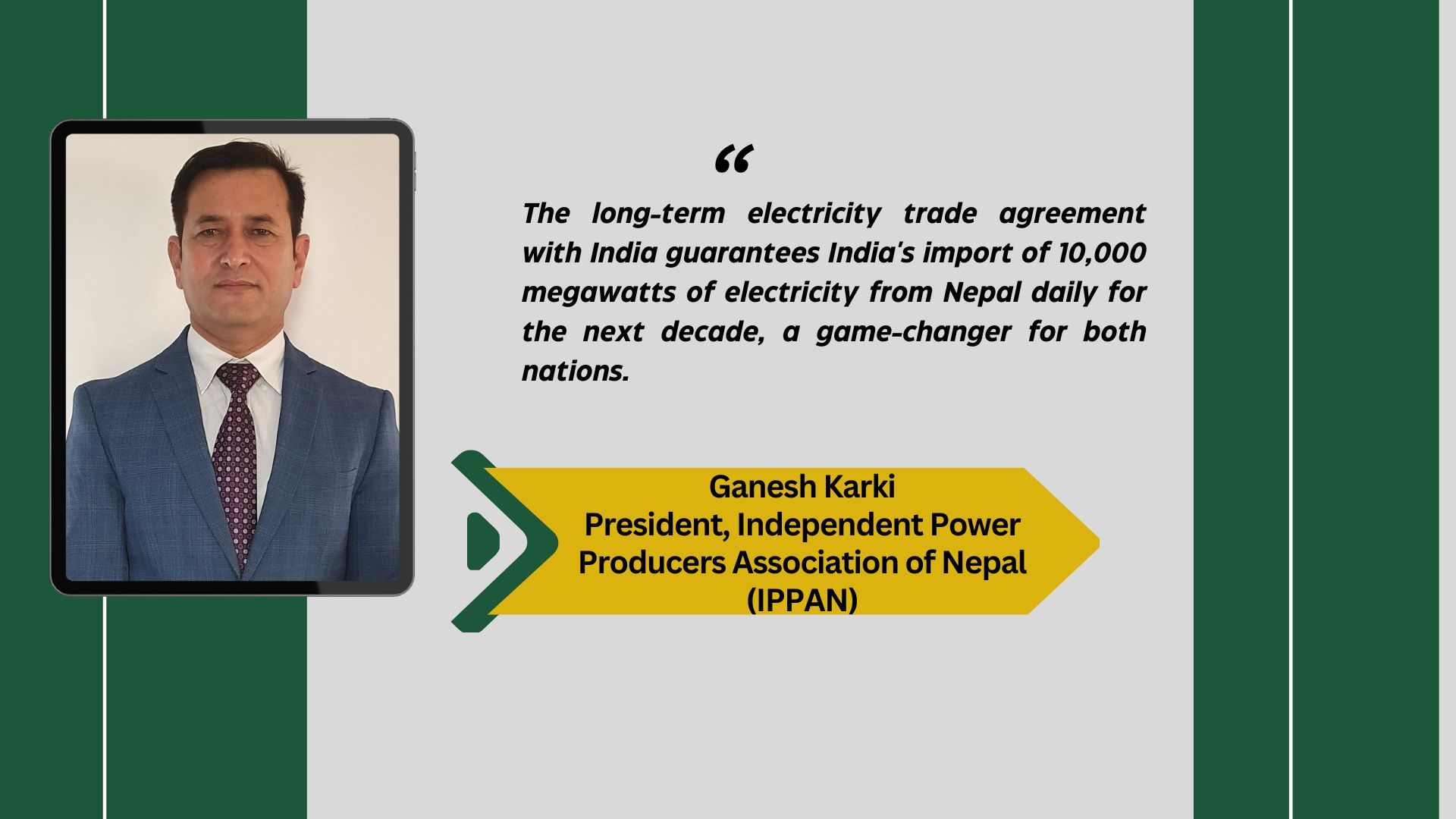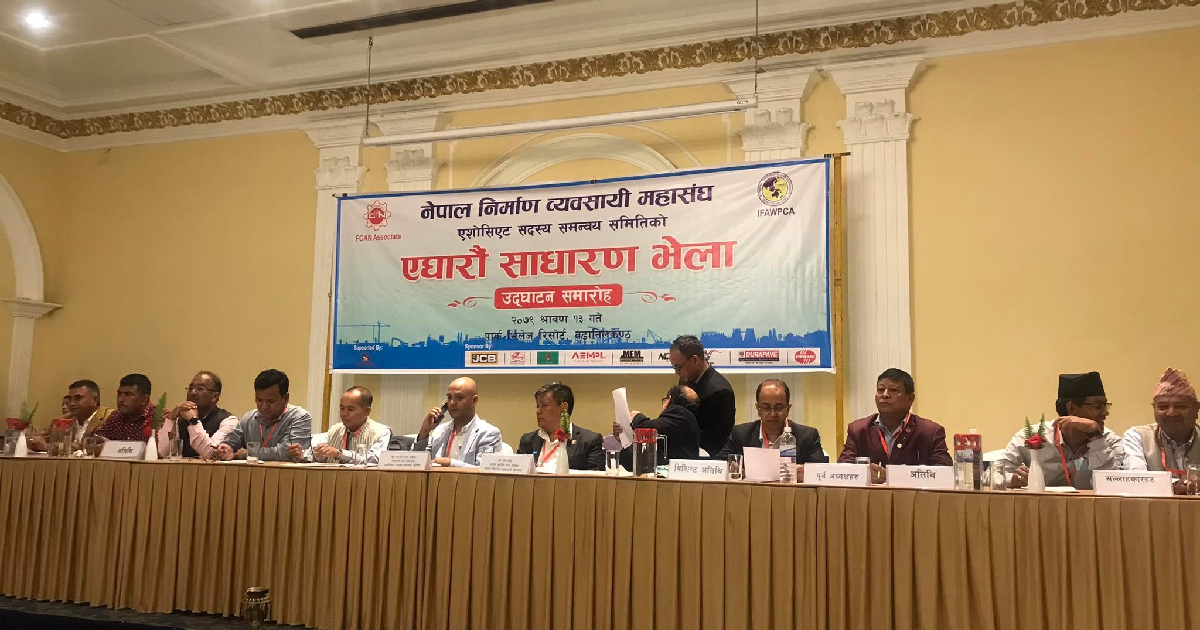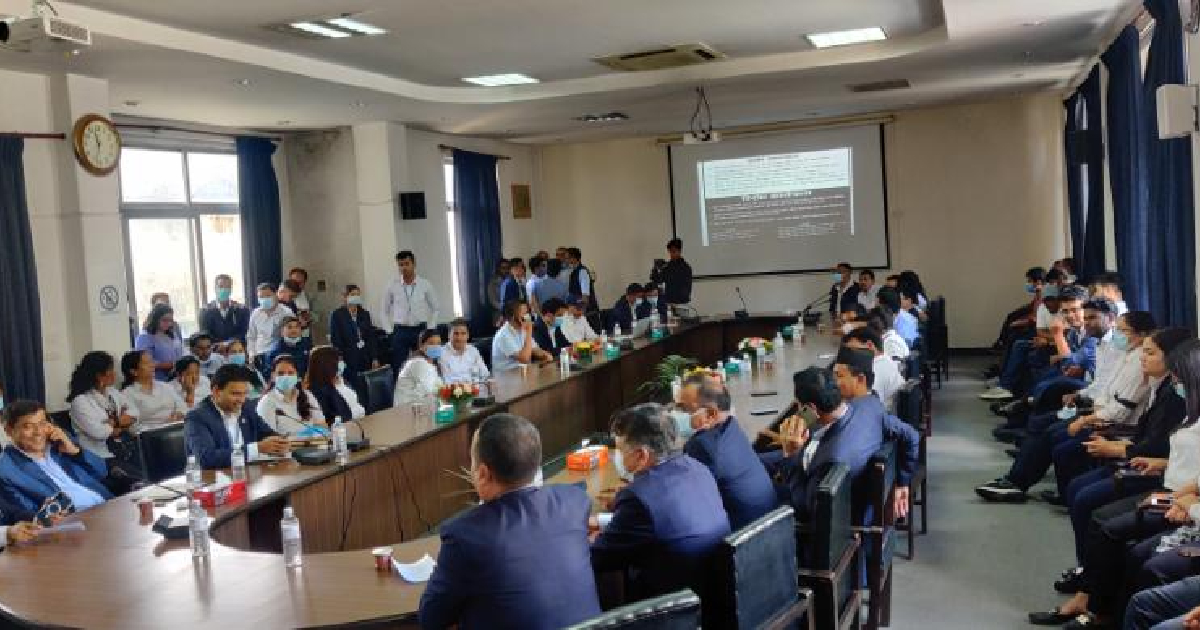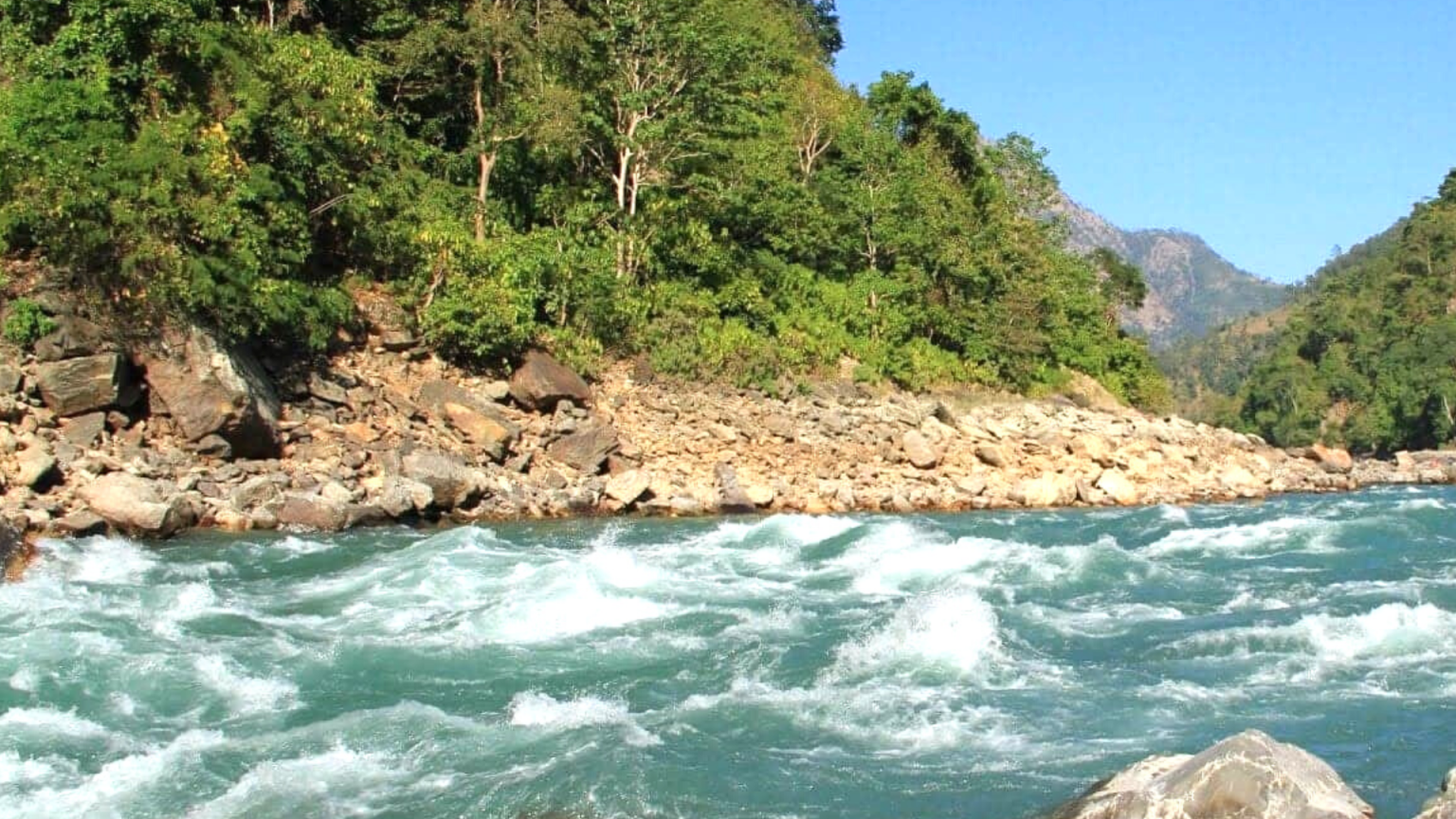

The history of Nepal’s hydropower production spans 112 years, with significant progress occurring only after the active engagement of the private sector. In 2057 BS, the first privately invested project generated electricity, marking a turning point. In the 23 years since then, the private sector has surpassed the government’s 90-year production of 600 megawatts by generating over 2,000 MW. Currently, Nepal’s hydroelectricity production is around 2,800 MW, with the private sector contributing 2,100 MW.
Presently, the private sector has undertaken the development of over 169 hydropower projects, with 91 of them being listed on the Nepal Stock Exchange. These projects have garnered investment from more than four million individuals. Additionally, hydroelectric projects with a combined capacity of 3,200 megawatts are currently under construction, and projects totaling 3,500 megawatts are in the process of financial closure. Furthermore, projects with a cumulative capacity of 12,000 megawatts are awaiting a Power Purchase Agreement (PPA) with the government, and the private sector is also studying the projects with a combined capacity of 12,000 MW. A study by the Water and Energy Commission shows that Nepal has the potential to generate 120,000 MW of hydroelectricity. Likewise, research also shows Nepal can generate 30,000 megawatts of solar power. Other multiple studies also found that Nepal can achieve a maximum electricity production of over 200,000 MW during the rainy seasons.
Since the introduction of the Electricity Act in 1992, the private sector has actively participated in the hydropower sector, contributing significantly to its overall development. Currently, the largest source of energy for Nepal remains the hydropower sector. However, solar energy is also equally important for Nepal. Lately, responding to the increased focus of the government on solar energy, a dozen solar projects with a combined capacity of 100 MW have started operation over the last five years and some other solar projects with a combined capacity of 1,000 MW are under construction. In all these initiatives–both hydro and solar, the private sector investment has reached over Rs 1,300 billion.
The opportunity
During Prime Minister Pushpa Kamal Dahal ‘Prachanda’s’ official visit to India last year, the southern neighbor announced its commitment to purchasing 10,000 MW of electricity from Nepal. At that time, the private sector recognized the immediate need for the resumption of the Power Purchase Agreement (PPA) and called for a collaborative effort in the construction of hydropower projects. Seven months after PM Dahal’s visit, Nepal and India signed an agreement to export 10,000 MW of electricity from Nepal to India in the next ten years.
The recent formalization of this long-term agreement between both neighbors indicates India’s readiness to import power produced by Nepali investors. Despite this agreement, the government has been hesitant to resume the Power Purchase Agreement. Fulfilling this agreement requires close collaboration between the government and the private sector. It is crucial to understand that Nepali investors can produce and export power to India only if the government creates a conducive environment.
Recognizing that prosperity is attainable only through the development of the power sector, the government is formulating directives to generate 28,500 MW of electricity by 2035. This target can only be achieved through a national consensus that facilitates uninterrupted hydropower development in Nepal.
Since the introduction of the Electricity Act in 1992, the private sector has actively participated in the hydropower sector, contributing significantly to its overall development. Currently, the largest source of energy for Nepal remains the hydropower sector. However, solar energy is also equally important for Nepal.
The never-ending debate on forest issues
While the government has given hope, there remains a sense of skepticism within the private sector as it fears that this hope might lead to disappointment. Despite efforts from the Prime Minister, ministers, and Chief of Army Staff, challenges related to forests and the environment in infrastructure projects persist. In a recent program, Prime Minister Dahal mentioned an incident where a tree was situated within the school compound. The school had requested permission from the Department of Forest to remove the tree, but the ministry denied the request. Unfortunately, the tree eventually fell, killing a student. Citing this example, the Prime Minister raised questions on the acts of Nepal.
Chief of Army Staff Prabhu Ram Sharma, during a meeting of a parliamentary committee, said that the construction of the Kathmandu-Terai Expressway is facing delays due to legal hurdles. Sharma, citing challenges such as Environmental Impact Assessment (EIA) issues, mentioned, “We informed the prime minister that four trees need to be felled. However, it has been nine months since then, and we are yet to receive approval from the Ministry of Forest,” expressing his frustration. “How can projects be completed on time under these circumstances?” he questioned.
According to Kulman Ghising, Executive Director of Nepal Electricity Authority, the construction of a transmission line hasn’t been completed in 12 years due to the Forest’s refusal to issue tree-cutting permission. These representative cases reflect the long-running legal hurdles that are hampering Nepal’s progress. There should be amendments and reforms to ensure that the acts support the development and prosperity of Nepal.
Does Nepal have enough time?
Nepali youths are increasingly choosing to go abroad due to a lack of confidence in the future of Nepal, and even industrialists are migrating to foreign countries. However, despite these trends, Nepali investors in the hydropower sector remain steadfast in their commitment to boosting this crucial industry. In the realm of infrastructure, hydropower stands out as an area with immense possibilities. Despite being power-independent during rainy seasons and exporting a surplus of 600 MW to the Indian market, Nepal still grapples with the challenge of importing electricity during dry seasons. This reliance on power imports from India is likely to persist until the completion of large reservoir-based projects or until about one-third of the total hydropower production is supplemented by solar energy.
The realization of a prosperous Nepal hinges on harnessing the immense potential offered by the hydropower sector. While serving as the economic backbone of the country, achieving this vision seems daunting in the current scenario. To turn this vision into reality, the government must create an investment-friendly environment and ensure investment security in hydropower development. Despite the private sector’s commendable contribution to Nepal’s hydropower development, the sector’s growth has been hindered by cumbersome procedures and government indifference to addressing bottlenecks.
Beyond merely granting licenses for private-sector hydropower development, the government has failed to undertake substantial work. Promised projects such as the construction of transmission lines and access roads remain unrealized. As our water resources flow away, it becomes imperative to utilize available water wisely and urgently, especially considering the potential effects of climate change leading to the drying up of rivers. Collaborative efforts between the government and the private sector are essential to achieving the common goal of prosperity by harnessing the immense potential of the hydropower sector judiciously.
Utilizing power in Nepal
If all sectors receive electricity according to their demand, Nepal could potentially consume up to 5,000 megawatts of power. Unfortunately, the country has struggled to meet the electricity demand. Granting licenses to the private sector for power distribution could address this issue, allowing for electricity trade both domestically and internationally. Opportunities also exist for selling power in industrial corridors, with companies already established and prepared for this purpose. However, the government has yet to grant the necessary permissions.
The Nepal Electricity Authority has forecasted that Nepal can annually export power worth Rs 15-20 billion. This year, the state-owned power monopoly exported electricity worth Rs 15 billion, with a substantial contribution from the private sector. Despite this, during the rainy season, a significant amount of electricity generated by many hydropower projects goes to waste. If the power generated by the private sector were utilized by the government, the export figures could have been even higher. Allowing the private sector to directly sell surplus energy would have enabled active exploration of markets for it.
While Nepal earns billions from exporting electricity, it encounters the challenge of having to buy power from India during dry seasons. Addressing this issue necessitates the government’s prioritization of the development of reservoir-based hydro projects and solar projects. However, constructing a reservoir-based project requires a significant time investment of at least 8-10 years and substantial financial resources. An alternative and more immediate approach is to focus on solar projects, which can be completed within a year.
The private sector is currently confronted with a significant challenge, as the government has put a halt on power purchase agreement (PPA) signings for the past five years. The number of projects has stagnated due to the government’s failure to initiate PPA openings since 2075. However, just a PPA of 1500 MW was allowed to conclude the agreement at the time of Deputy Primeminister and Energy Minister Rajendra Prasad Lingden.
Now we urging the to government allow PPA for all waiting projects at the Nepal Electricity Authority. We have requested a one-year extension to manage finances for the project. Failure to secure this extension would make achieving the set targets of power production in the next 10 years extremely challenging. The government must act decisively during this critical period, as the next decade poses significant challenges for Nepal. Additionally, addressing legal hurdles and creating a favorable environment for banks and financial institutions to invest in hydro projects is essential.
If the government is genuinely focused on hydropower development, we suggest the government declare a ‘state of emergency’ in the power sector to expedite project development ensuring timely and cost-effective completion of crucial energy projects
‘Energy Development Decade’ in power sector
The private sector demands to set a target of 30,000 MW of electricity production in 10 years, with 10,000 megawatts consumed domestically and the remaining exported to international markets. However, the government has formulated a plan for 28,500 MW of production in 2035. This is also a good plan, but currently, various laws pose obstacles. The situation is such that it takes 10 years for the government to install a transmission line. With such laws in place, achieving the target of producing 30,000 megawatts of electricity in the next 10 years will be extremely challenging.
In the current situation, a project can be completed within five years if there are no procedural hassles. However, the lengthy process extends the same project’s timeline to 10 to 15 years and doubles the project cost to make power more expensive. Currently, around Rs 200 million is required for the production of 1 MW of hydropower. However, due to procedural delays, the timeline extends, and the cost increases to around Rs 250 million.
If the government is genuinely focused on hydropower development, we suggest the government declare a ‘state of emergency in the energy sector’ in the power sector to expedite project development ensuring timely and cost-effective completion of crucial energy projects. If procedural hindrances are minimized, the bank interest rate is set at a single digit, and there is a smooth land acquisition process, along with favorable forest-related laws being addressed, the project cost could be further reduced even in the present circumstances. Without such moves, achieving the government’s set targets in the power sector appears nearly impossible.
Conclusion
To date, our primary source of energy has been hydropower, and it will remain a top priority. However, prompt harnessing of our natural resources and assets is crucial to avoid potential challenges in hydropower in the future. Globally, new technologies are emerging, with hydrogen energy gaining prominence and challenging traditional energy sources. Hydrogen cars are already available in the market as an alternative to electric cars. Ongoing research in electricity production includes scientists working on extracting energy from rainwater collected on roofs to generate electricity for homes. If successful, this technology could revolutionize electricity generation, allowing households to produce power from rainwater collected on their roofs. Currently, hydrogen energy is being produced from hydropower, but in the future, it may be possible to extract hydrogen directly from water, opening up new possibilities for sustainable energy sources. As technological advancements continue, Nepal needs to seize the immense possibilities and opportunities within its reach.
Currently, the government has only granted permission to the private sector for electricity production. As the government is the sole buyer, there is no competition in the pricing of generated electricity. Moreover, when the government fails to distribute electricity, the private sector bears the resulting losses. So we urging the government to introduce legal instruments to create the involvement of the private sector, in the study, development, and operation of energy projects and energy systems as the larger perspective of energy trade.
(Karki is the President of the Independent Power Producers Association, Nepal (IPPAN), His article is taken from a recently published memoir titled ‘Urja Samriddhi’ by the IPPAN)










